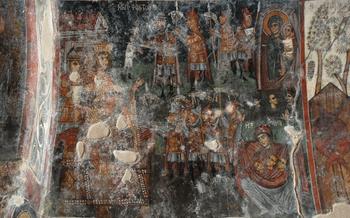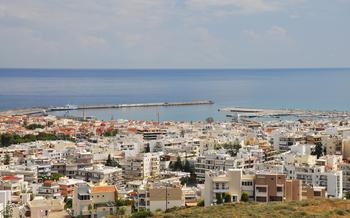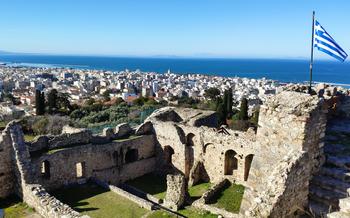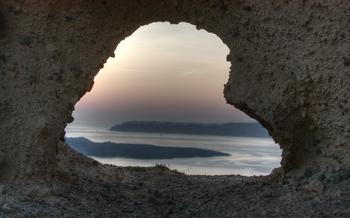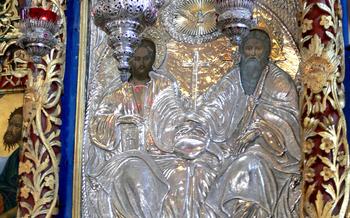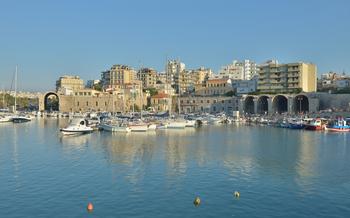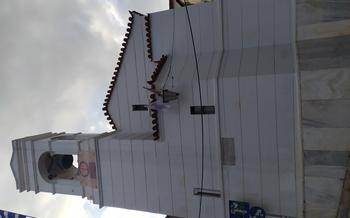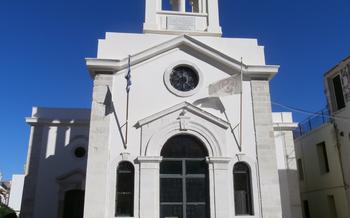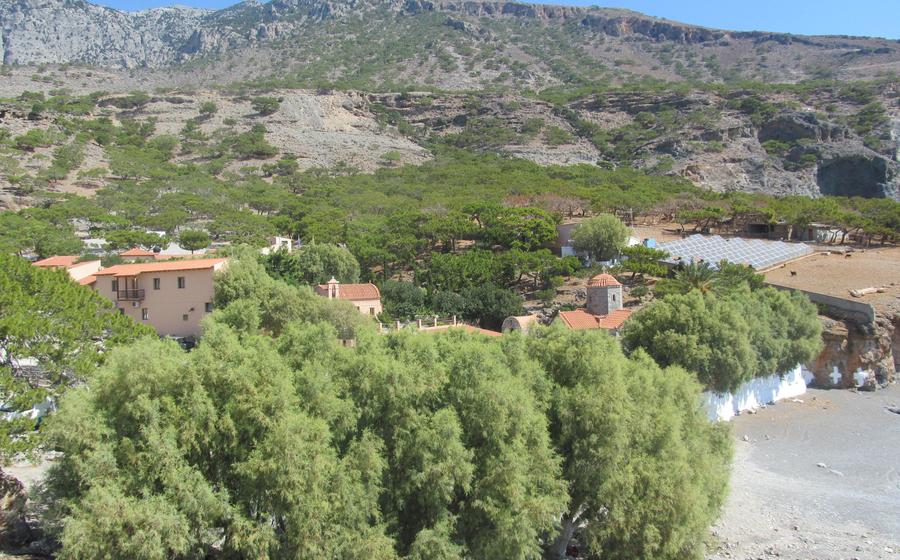
Koudoumas Monastery
- Historical Background
- Architectural Marvel
- Religious Significance
- Artistic Treasures
- Monastic Life
- Pilgrimage Experience:
- Stunning Views:
- Local Traditions
- Olive Oil Production
- Winemaking Tradition:
- Handicrafts and Souvenirs:
- Guided Tours: Unveiling Hidden Treasures and Untold Stories
- Accessibility
- Dress Code
- Insider Tip: Experience the Olive Harvest
Historical Background
Founded in the 14th century, the Koudoumas Monastery stands as a testament to the rich history of Crete. Nestled amidst the picturesque hills of Heraklion, the monastery has played a pivotal role as a spiritual and cultural center throughout the centuries. During the Venetian rule, it flourished as a renowned religious institution, attracting pilgrims and scholars alike. Under Ottoman rule, the monastery faced challenges but managed to preserve its spiritual heritage. In the 20th century, extensive restoration efforts were undertaken, ensuring the preservation of its architectural integrity. Today, the Koudoumas Monastery stands as a living testament to its enduring legacy, inviting visitors to explore its storied past and immerse themselves in its sacred atmosphere.
Architectural Marvel
The Koudoumas Monastery stands as a testament to the architectural prowess of its Byzantine and Venetian builders. Its intricate stonework and frescoes are a feast for the eyes, showcasing the skill and artistry of the craftsmen who created them. Explore the various sections of the monastery, including the church, refectory, and living quarters, each with its own unique charm and historical significance. Marvel at the well-preserved frescoes depicting religious scenes and historical events, offering a glimpse into the monastery's rich past. Appreciate the monastery's unique blend of Byzantine and Venetian architectural elements, a testament to the diverse influences that have shaped Crete's cultural heritage.
Religious Significance
The Koudoumas Monastery holds immense religious significance as a sacred pilgrimage site for Greek Orthodox Christians. It has been a spiritual center since its founding, playing a crucial role in the religious life of the region. The monastery is dedicated to the Virgin Mary, and its main church is adorned with exquisite icons and frescoes depicting her life and miracles. Pilgrims from all over Greece and beyond flock to the monastery to seek spiritual guidance, pray for blessings, and venerate the holy relics housed within its walls. The monks, who reside at the monastery, are known for their piety and devotion, and they offer spiritual counseling and guidance to visitors seeking solace and inner peace.
Artistic Treasures
Within the hallowed walls of the Koudoumas Monastery, a treasure trove of artistic wonders awaits the discerning eye. The monastery's collection of exquisite icons stands as a testament to the skill and devotion of Byzantine and post-Byzantine artisans. Each icon, meticulously crafted with vibrant colors and intricate gold leaf, depicts religious figures and scenes with remarkable realism and emotion.
The monastery's frescoes, adorning the walls and ceilings of the church and other buildings, transport visitors to another era. These vibrant murals, created by talented artists over the centuries, depict biblical narratives, the lives of saints, and historical events with stunning detail and expressiveness.
Intricate wood carvings and metalwork further enhance the monastery's artistic legacy. From the finely carved iconostases to the ornate chandeliers, every element of the monastery's interior showcases the exceptional craftsmanship of its creators.
Discover the artistic treasures of the Koudoumas Monastery, where the sacred and the beautiful harmoniously intertwine, leaving an indelible mark on the hearts and minds of visitors.
Monastic Life
Immerse yourself in the daily life of the monks who reside at the Koudoumas Monastery, gaining insights into their traditions and practices. Understand the significance of prayer, meditation, and work in their lives, and discover the challenges and rewards of monasticism. Learn about the unique bond they share with the monastery and the community, and witness the dedication and devotion that guide their way of life. Engage in conversations with the monks to gain a deeper understanding of their experiences and perspectives, and leave with a newfound appreciation for the spiritual journey they have embarked on.
Pilgrimage Experience:
The Koudoumas Monastery serves as a popular pilgrimage site for devout Orthodox Christians from around the world. Pilgrims come to seek spiritual guidance, offer prayers, and experience the monastery's serene atmosphere. Participate in religious services, such as the Divine Liturgy and prayer sessions, to immerse yourself in the spiritual essence of the monastery. Light a candle or leave an offering at the monastery's shrines to express your devotion. Seek spiritual guidance and blessings from the monks, who are known for their wisdom and compassion. The monastery's spiritual atmosphere and the opportunity for personal reflection make it a transformative experience for pilgrims.
Stunning Views:
The Koudoumas Monastery is perched on a hilltop, offering visitors breathtaking views of the surrounding countryside. From the monastery's elevated vantage point, you can admire the lush green valleys, olive groves, and distant mountains. The panoramic vistas are particularly stunning at sunset, when the sky is painted with vibrant hues of orange, pink, and purple.
Be sure to bring your camera to capture the picturesque landscape. The monastery's surroundings are a photographer's paradise, with endless opportunities for capturing stunning shots. Whether you're interested in panoramic vistas, close-up details of the monastery's architecture, or candid shots of the monks going about their daily lives, you're sure to find plenty of inspiration here.
In addition to the beauty of the natural scenery, the monastery itself is a sight to behold. The whitewashed walls and red-tiled roofs of the buildings contrast beautifully with the green of the surrounding vegetation. The monastery's bell tower, which rises above the rest of the complex, offers particularly stunning views.
Take some time to relax and soak in the tranquility of the monastery's surroundings. Find a quiet spot to sit and enjoy the peace and serenity of the landscape. Let the beauty of nature wash away your worries and leave you feeling refreshed and rejuvenated.
Local Traditions
The Koudoumas Monastery is deeply intertwined with the local traditions and customs of the region. For centuries, the monastery has served as a spiritual and cultural center, hosting religious festivals and celebrations that bring together the local community. These events showcase the rich heritage of the area, featuring traditional dances, music, and food.
During the annual feast day of the monastery, which typically falls in September, pilgrims and visitors from neighboring villages gather to celebrate. The monastery's courtyard transforms into a vibrant festival ground, filled with the sounds of traditional music, the aroma of delicious food, and the lively energy of the community.
Visitors can witness traditional Cretan dances, such as the "Pentozali" and the "Sousta," performed by skilled dancers in colorful costumes. The monastery's courtyard echoes with the rhythm of drums and lyres, creating a festive atmosphere that invites everyone to join in the celebration.
Local women demonstrate their culinary skills by preparing traditional dishes, such as "dakos," a barley rusk topped with tomatoes, feta cheese, and olive oil, as well as "gamopilafo," a saffron-infused rice dish served at weddings and other special occasions. The monastery's courtyard becomes a culinary haven, where visitors can savor the flavors of authentic Cretan cuisine.
Through these festivals and celebrations, the Koudoumas Monastery plays a vital role in preserving and promoting the local traditions and customs of the region. Visitors are invited to immerse themselves in the vibrant atmosphere, experience the warmth of the local community, and create lasting memories of their time at the monastery.
Olive Oil Production
The Koudoumas Monastery is deeply involved in olive oil production, a vital part of the local economy and a centuries-old tradition in Crete. The monks have their own olive groves, where they cultivate and harvest olives using traditional methods. They carefully tend to the trees, prune them, and hand-pick the olives when they reach their peak ripeness.
Once harvested, the olives are transported to the monastery's olive press, where they are processed using a combination of traditional and modern techniques. The olives are crushed and pressed to extract the precious oil, which is then stored in stainless steel tanks. The monks oversee the entire process, ensuring that the highest quality standards are maintained.
The resulting olive oil is renowned for its exceptional quality and flavor. It is a rich, golden-green oil with a fruity aroma and a slightly peppery finish. The monks use the olive oil for their own consumption, as well as to produce various products, such as soaps and cosmetics.
Visitors to the monastery can sample the monastery's olive oil and purchase bottles to take home as a souvenir. The monks are happy to share their knowledge about olive cultivation and oil production, providing visitors with a unique insight into this important aspect of Cretan life.
Winemaking Tradition:
Unveiling the Koudoumas Monastery's centuries-old tradition of winemaking is a journey into the heart of Greek viticulture. Nestled amidst rolling hills and lush vineyards, the monastery has been crafting exceptional wines using traditional techniques and local grape varieties for generations.
Explore the monastery's vineyards, where rows of vines bask in the Mediterranean sun, carefully tended by the monks. Learn about the meticulous process of grape cultivation and harvesting, passed down from generation to generation.
Step into the monastery's wine cellar, a treasure trove of aging barrels and oak casks. Inhale the heady aroma of fermenting grapes and discover the secrets behind the monastery's unique wines. Sample their rich flavors and distinct characteristics, a testament to the monks' dedication and expertise.
Delve into the significance of wine in Greek culture and cuisine. From religious rituals to festive celebrations, wine holds a special place in the hearts of Greeks. Experience the joy of sharing a glass of monastery-made wine with friends and family, a symbol of camaraderie and hospitality.
Whether you're a wine enthusiast or simply seeking a taste of authentic Greek tradition, the Koudoumas Monastery's winemaking heritage offers a captivating and unforgettable experience.
Handicrafts and Souvenirs:
Discover the monastery's workshop, where skilled artisans create beautiful handicrafts and souvenirs that reflect the monastery's rich history and artistic traditions. Witness the traditional techniques used to create intricate wood carvings, pottery, and jewelry. Purchase unique souvenirs, such as handmade rosaries, icons, and ceramics, as a reminder of your visit. Support the monastery's efforts to preserve traditional crafts and generate income to sustain its ongoing operations.
Guided Tours: Unveiling Hidden Treasures and Untold Stories
Enhance your visit to the Koudoumas Monastery by taking advantage of the guided tours offered by knowledgeable guides. These experts will lead you through the monastery's fascinating history, architecture, and religious significance, bringing the past to life with captivating stories and anecdotes. Discover hidden corners and secret passages that are not accessible to the general public, gaining a deeper understanding of the monastery's hidden treasures. Customize your tour to focus on specific areas of interest, whether it's the monastery's Byzantine frescoes, its role in the Greek Orthodox Church, or its centuries-old tradition of winemaking. Guided tours provide an immersive and enriching experience, allowing you to delve into the heart and soul of this sacred site.
Accessibility
Reaching the Koudoumas Monastery is a breeze, whether you opt for a scenic drive, a convenient bus ride, or a hassle-free organized tour. If you're self-driving, simply follow the well-marked signs leading to the monastery, immersing yourself in the picturesque landscapes along the way. Alternatively, hop on a public bus from Heraklion, which offers a budget-friendly and direct route to the monastery's doorstep.
To make the most of your visit, plan your trip during the monastery's welcoming opening hours, typically from morning until late afternoon. Before you embark on your journey, check the monastery's website or contact them directly to inquire about any special events or services that might enhance your experience.
For an unforgettable and immersive stay, consider booking a room at the monastery's guesthouse. This unique opportunity allows you to fully embrace the tranquil ambiance, engage with the resident monks, and delve deeper into the monastery's rich history and traditions.
Dress Code
When visiting the Koudoumas Monastery, it is important to be mindful of the dress code in order to show respect for the religious nature of the site. Modesty and decorum are highly valued, so visitors are required to dress accordingly. Avoid wearing shorts, tank tops, or revealing clothing that might be considered inappropriate for a sacred space. Instead, opt for attire that covers your shoulders and knees, such as long pants or skirts, and shirts with sleeves. By dressing respectfully, you demonstrate your understanding and appreciation for the monastery's spiritual significance.
Insider Tip: Experience the Olive Harvest
Plan your visit to the Koudoumas Monastery during the annual olive harvest, usually held in November, to immerse yourself in the traditional process of olive picking and pressing. Witness the monks and local farmers carefully handpick the ripe olives from the surrounding groves, using ancient techniques passed down through generations. Learn about the importance of olive cultivation in the region and its role in the monastery's economy.
Savor the opportunity to taste freshly pressed olive oil, renowned for its exceptional quality and flavor. Engage with the monks and locals to understand the health benefits and culinary uses of Greek olive oil, a staple of the Mediterranean diet. Participate in the festivities and celebrations that accompany the harvest season, such as traditional dances, music, and food tasting. This unique experience offers a glimpse into the agricultural heritage of Crete and the deep connection between the monastery and its surrounding community.
